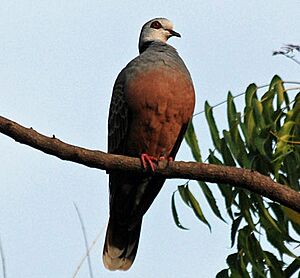Adamawa turtle dove facts for kids
Quick facts for kids Adamawa turtle dove |
|
|---|---|
 |
|
| Poli, Cameroon | |
| Conservation status | |
| Scientific classification | |
| Genus: |
Streptopelia
|
| Species: |
hypopyrrha
|
The Adamawa turtle dove (Streptopelia hypopyrrha) is a type of bird. It belongs to the pigeon and dove family, called Columbidae. This bird is also known as the pink-bellied turtle dove. It is very similar to the dusky turtle dove.
This dove lives in different, separate parts of Africa. You can find it in countries like Cameroon, Nigeria, and Chad. It also lives further west in Gambia, Senegal, and Mali. Some people have seen it in Togo, so it might live there too.
Contents
About the Adamawa Turtle Dove
What Does It Look Like?
The Adamawa turtle dove is about 30 to 31 centimeters (12 to 12.2 inches) long. It weighs between 147 and 187 grams (5.2 to 6.6 ounces). That's about as heavy as a small apple!
This bird has a silver-grey face and a blue-grey head. It has a special dark black patch on its shoulder. Its belly and chest are pink. The top parts of its body are brown with grey-brown edges. Female doves and young doves are usually lighter in color than the males.
Where Does It Live?
The Adamawa turtle dove lives in many different places. It can be found from sea level up to 1,200 meters (3,900 feet) high. It likes areas with forest edges and wooded ravines.
You can also find it in gallery forests, which are forests along rivers. It sometimes lives in suburban gardens and on farmland. We are not sure if these doves travel long distances or just move around. Their movements might just mean we don't know enough about them yet.
What Does It Eat?
We don't know much about how the Adamawa turtle dove behaves. It eats seeds that it finds on the ground. Sometimes, these doves gather in large groups. You might see up to 60 birds together when they are not breeding. They sometimes feed with other types of doves too.
How Does It Raise Its Young?
Adamawa turtle doves usually breed at the end of the dry season. The male dove performs a special flight to attract a female. He flaps his wings fast to fly upwards. Then, he glides slowly back down.
Both parents work together to build the nest. Their nest is often quite flimsy. The female lays two white eggs.
Conservation Status
Experts checked the Adamawa turtle dove's conservation status in 2012. They decided it is a species of least concern. This means it is not currently in danger of disappearing.


